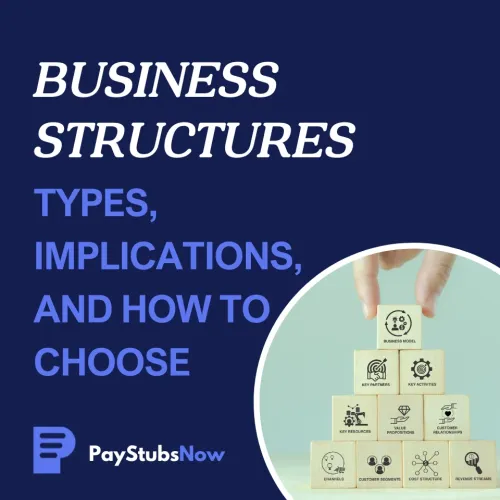


Choosing the right business structure is one of the most critical decisions an entrepreneur makes. It can influence daily operations and growth potential but also plays a significant role in legal protections and tax liabilities. Understanding these nuances is essential for aspiring business owners and seasoned entrepreneurs alike.
This article explores various business entity types and examines their implications for taxes, personal liabilities, and operational complexities. By providing a comprehensive comparison of each structure, we aim to provide business owners like you with valuable insights to make an informed decision that aligns with your company goals, risk tolerance, and administrative requirements.
A business structure refers to the legal framework within which organizations operate. These structures dictate how a business is treated in terms of legal liability, taxation, and administrative responsibilities. The structure you choose establishes the relationship between the business and its owners.

Your chosen business structure affects critical aspects of your business:
 Let's explore the most common business structures, focusing on their implications on taxes, liability, and daily operations to guide your decision-making process.
Let's explore the most common business structures, focusing on their implications on taxes, liability, and daily operations to guide your decision-making process.
A sole proprietorship is the most straightforward business structure, owned and managed by one individual. This arrangement has no legal distinction between the owner and the business, which means the sole proprietor bears full responsibility for any debts or liabilities incurred. While the simplicity of reporting business income and expenses on a personal tax return afforded by a sole proprietorship business structure is appealing, it also requires paying self-employment taxes for Medicare and Social Security .
Despite owning all profits, sole proprietors are personally liable for business losses—a risk that can extend from business assets to the owner's personal assets such as homes and cars. Tax benefits include the ability to deduct business expenses like travel, operating costs, and payments to contractors on Schedule C. It's crucial to note that income is taxable whether held in personal or business accounts, and making estimated quarterly tax payments can streamline the process.
When considering the partnership business structure, it's crucial to understand their characteristics and benefits. Partnerships involve multiple owners who share profits, losses, and personal liabilities. They serve as pass-through entities, meaning profits and losses are reported on the owners' personal income tax returns, which can simplify tax reporting compared to corporations. While basic partnerships don't need to be registered with the state, more complex partnership structures do. Overall, partnerships offer a less costly and easier setup than corporations, which makes them attractive to many entrepreneurs.
Here are the four partnership types.
The Limited Liability Company (LLC) has emerged as a highly popular business structure due to its relative ease of formation and maintenance, coupled with the benefit of personal liability protection. Owners of an LLC are referred to as "members," and the business can be managed by the members themselves or by a hired manager. An LLC can have a single member or multiple members. While some entrepreneurs choose to handle the formation paperwork themselves, many opt for the services of a registered agent to manage the official filings and communications.
The LLC is often a hybrid business structure, offering a blend of features from other business entities. A key advantage is that it provides personal liability protection to its owners. As a separate legal entity, the personal assets of the LLC members are generally shielded from business debts and legal judgments against the company.
Taxation for an LLC offers significant flexibility. Members can elect how the Internal Revenue Service will treat the business for tax purposes. A single-member LLC can be treated as a sole proprietorship or a corporation, allowing the owner to report income and pay taxes accordingly. A multi-member LLC can be taxed as a partnership or a corporation. This flexibility allows business owners to choose the tax structure that best suits their financial situation.
Corporations are independent legal entities, separate from their founders. They offer strong liability protection and can exist beyond the lives of the original owners. However, they also require more formalities and oversight. Below are the two most common types:
 The following table provides a simplified comparison of the key aspects of each business structure:
The following table provides a simplified comparison of the key aspects of each business structure:
**Business Structure**
Tax Treatment
Personal Liability
Ownership
Taxes
**Sole Proprietorship**
Pass-through; income reported on personal return and subject to self-employment tax
Unlimited personal liability (no legal distinction between owner and business)
Single owner
Owner pays all taxes on personal return, including self-employment taxes
**Partnership**
Pass-through; each partner reports their share of income and losses on a personal tax return
General partners have unlimited liability; limited partners’ liability is restricted to their investment
Two or more owners (general or limited partners). Liability protections vary, especially with LP, LLP, and LLLP structures
Partners pay taxes on their share of profits, which may include self-employment taxes for active partners
**LLC**
Can choose to be taxed as sole proprietorship, partnership, or corporation
Limited liability for all members; personal assets generally protected from business debts and legal judgments
Single or multiple members. Flexible management structure, either member-managed or manager-managed
Owners can pay taxes as a pass-through entity or opt for corporate tax rates
**C Corp**
Files its own corporate tax return at federal and state levels (double taxation possible)
Limited liability for shareholders
Unlimited shareholders. Must follow corporate formalities (e.g., bylaws, board of directors, annual meetings)
Corporation pays taxes on profits. Shareholders pay taxes again on dividends or other distributions
**S Corp**
Pass-through taxation; owners report profits/losses on personal returns
Limited liability for shareholders
Limited to 100 shareholders. Must meet IRS requirements for S Corp status
Profits pass through to owners, avoiding corporate-level tax, but owners must report income on personal tax returns
 As you start your business, selecting the right business structure is among the key factors to consider. Here's a step-by-step guide to help you make an informed decision.
As you start your business, selecting the right business structure is among the key factors to consider. Here's a step-by-step guide to help you make an informed decision.
What are your short-term and long-term objectives? Do you plan for rapid growth, seek external investment, or prioritize simplicity? Your goals will influence the suitability of different structures.
Determine how much personal protection you need. If you operate in a high-risk industry, you might require a structure offering stronger liability shields, such as an LLC or corporation.
Understand the tax implications of each structure and how they align with your financial situation. Do you prefer pass-through taxation or are you comfortable with corporate taxes?
Think about whether you want multiple owners, active partners, or the flexibility to bring in silent investors. Some structures facilitate outside investment more than others.
Be realistic about the administrative burden associated with each structure. Corporations, for instance, typically involve more stringent compliance requirements than sole proprietorships.
Given the complexities involved, it's highly recommended to seek advice from a legal or tax professional. They can provide personalized guidance based on your specific business and circumstances.
No matter which entity you choose, maintaining clear and accurate financial records is crucial. From running accurate calculations to ensuring compliance, most business owners need a fast, reliable way to generate payroll documentation. This is where Paystubsnow can help:
Paystubsnow simplifies the creation of professional paystubs for your employees or contractors. This ensures accurate documentation of earnings and deductions, which is crucial for tax compliance across any business structure.
By providing clear and organized pay records, Paystubsnow helps simplify your overall recordkeeping. This can ease the burden of tax preparation, whether you're filing as a sole proprietor, partnership, LLC, or corporation.
Whether you hire employees or work with independent contractors, the platform can generate necessary payment documentation (invoices and pay stubs), helping you maintain compliance with labor laws and tax regulations.
Paystubsnow offers an affordable and user-friendly solution for generating paystubs and tax forms. It eliminates the need for complex software or manual calculations, so you can generate the documents you need from anywhere, at any time.
Owning a business brings unique challenges and rewards, including taxes, liability, and paperwork. One way to avoid some of these hardships is by choosing the right business structure. It’s important to pick the right one right off the bat since your chosen structure may affect the liability you face, your tax burden, and even your business’s ability to grow.
Once you have a clear path forward, consider leveraging Paystubsnow to generate paystubs and tax forms that simplify your administrative burdens. By streamlining these financial tasks, you can remain focused on what truly matters—growing and sustaining your business